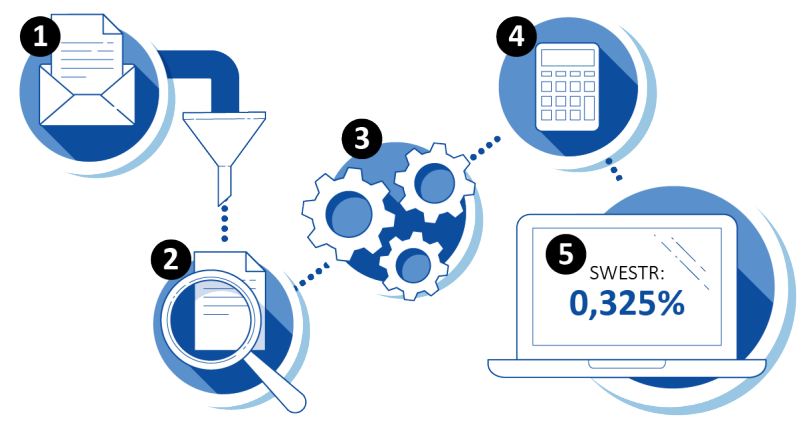Process for the publication of SWESTR
The reference rate SWESTR (Swedish krona Short Term Rate) is published on the Riksbank’s website at 09:00 every banking day. The reference rate is calculated on the basis of the previous banking day’s transactions conducted on the Swedish money market. Here follows a description of the process from the reporting of transaction data by the reporting agencies to the publication of SWESTR.
The figure below illustrates what happens during the daily process for determining and publishing SWESTR. The process is also described in more detail in points 1-5 further down on this page. Please refer to the Framework for the transaction-based reference rate SWESTR for detailed information.

From reporting data to publishing SWESTR
Reporting
Early in the morning, a number of reporting agencies report transaction data to the Riksbank. These are transactions executed on the Swedish money market on the previous banking day. The reporting agencies are those of the Riksbank’s monetary policy counterparties that are the largest and most active on the money market in Swedish krona. The transactions reported undergo automatic and manual controls to ensure data quality. The filters used for these controls are updated on a daily basis. The transactions forming the basis for SWESTR are unsecured transactions in Swedish kronor for the maturity overnight (O/N).
Review
The Riksbank reviews compliance of the transaction dataset with the robustness requirements for SWESTR.
Data processing
The transaction dataset is processed by trimming 25 per cent of the transaction volume. Trimming reduces the impact from extreme values on SWESTR.
Calculation
The following two calculation methods are available for SWESTR:
- The normal calculation method is applied if all robustness requirements have been fulfilled. SWESTR is calculated as a volume-weighted mean rate based on the trimmed calculation dataset.
- The alternative calculation method is applied if the current transaction basis does not meet all requirements for robustness or in the event of technical problems making the current day’s transactions unavailable. In this case, SWESTR is based on a volume-weighted average of the previous banking day's value and today's value calculated using the normal calculation method. If transaction data for the current banking day is missing, this is equivalent to the valuation from the previous banking day.
Publication
SWESTR is published at 09.00 (CET). The publication of SWESTR, expressed to the third decimal place, also includes the following information (before trimming):
- Number of transactions on which the calculation is based
- Total transaction volume
- Number of reporting agencies
- Calculation method used: normal or alternative
- If appropriate, the reason why the alternative calculation method has been used
The API provided by the Riksbank for SWESTR is the primary source and the reference rate figure published on the Riksbank’s website is taken from this API.
When necessary, a corrected reference rate will be published
If new or amended transaction data is reported to the Riksbank after calculation of SWESTR has been completed for publication at 09:00, the Riksbank will make a new calculation. In this process, the process above for determination and publishing restarts from the beginning.
If the deviation between the recalculated value and publication at 09:00 is greater than two basis points, a corrected reference rate will be published at 12:00. The corrected value for SWESTR replaces the published value from 09:00 as the reference rate. In case a corrected value for SWESTR is published the information about the transaction dataset will also be updated.
More information
For more information about calculation method, transaction dataset and robustness requirements see Calculation method and transaction dataset for SWESTR.
Thanks for your feedback!
Your comment could not be sent, please try again later

Questions? Visit our FAQ on kundo.se (opens i new window).